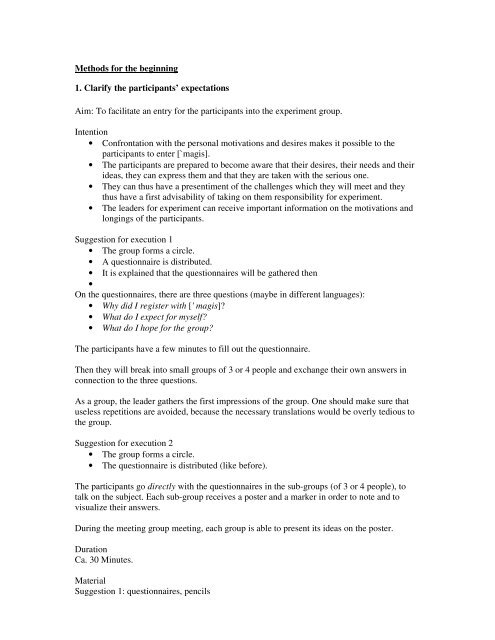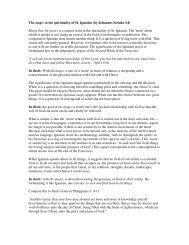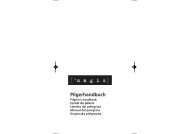Methods for the beginning 1. Clarify the participants' expectations ...
Methods for the beginning 1. Clarify the participants' expectations ...
Methods for the beginning 1. Clarify the participants' expectations ...
Create successful ePaper yourself
Turn your PDF publications into a flip-book with our unique Google optimized e-Paper software.
<strong>Methods</strong> <strong>for</strong> <strong>the</strong> <strong>beginning</strong><br />
<strong>1.</strong> <strong>Clarify</strong> <strong>the</strong> participants’ <strong>expectations</strong><br />
Aim: To facilitate an entry <strong>for</strong> <strong>the</strong> participants into <strong>the</strong> experiment group.<br />
Intention<br />
• Confrontation with <strong>the</strong> personal motivations and desires makes it possible to <strong>the</strong><br />
participants to enter [`magis].<br />
• The participants are prepared to become aware that <strong>the</strong>ir desires, <strong>the</strong>ir needs and <strong>the</strong>ir<br />
ideas, <strong>the</strong>y can express <strong>the</strong>m and that <strong>the</strong>y are taken with <strong>the</strong> serious one.<br />
• They can thus have a presentiment of <strong>the</strong> challenges which <strong>the</strong>y will meet and <strong>the</strong>y<br />
thus have a first advisability of taking on <strong>the</strong>m responsibility <strong>for</strong> experiment.<br />
• The leaders <strong>for</strong> experiment can receive important in<strong>for</strong>mation on <strong>the</strong> motivations and<br />
longings of <strong>the</strong> participants.<br />
Suggestion <strong>for</strong> execution 1<br />
• The group <strong>for</strong>ms a circle.<br />
• A questionnaire is distributed.<br />
• It is explained that <strong>the</strong> questionnaires will be ga<strong>the</strong>red <strong>the</strong>n<br />
•<br />
On <strong>the</strong> questionnaires, <strong>the</strong>re are three questions (maybe in different languages):<br />
• Why did I register with [' magis]<br />
• What do I expect <strong>for</strong> myself<br />
• What do I hope <strong>for</strong> <strong>the</strong> group<br />
The participants have a few minutes to fill out <strong>the</strong> questionnaire.<br />
Then <strong>the</strong>y will break into small groups of 3 or 4 people and exchange <strong>the</strong>ir own answers in<br />
connection to <strong>the</strong> three questions.<br />
As a group, <strong>the</strong> leader ga<strong>the</strong>rs <strong>the</strong> first impressions of <strong>the</strong> group. One should make sure that<br />
useless repetitions are avoided, because <strong>the</strong> necessary translations would be overly tedious to<br />
<strong>the</strong> group.<br />
Suggestion <strong>for</strong> execution 2<br />
• The group <strong>for</strong>ms a circle.<br />
• The questionnaire is distributed (like be<strong>for</strong>e).<br />
The participants go directly with <strong>the</strong> questionnaires in <strong>the</strong> sub-groups (of 3 or 4 people), to<br />
talk on <strong>the</strong> subject. Each sub-group receives a poster and a marker in order to note and to<br />
visualize <strong>the</strong>ir answers.<br />
During <strong>the</strong> meeting group meeting, each group is able to present its ideas on <strong>the</strong> poster.<br />
Duration<br />
Ca. 30 Minutes.<br />
Material<br />
Suggestion 1: questionnaires, pencils
Suggestion 2: questionnaires, markers, poster board<br />
Preparation<br />
Prepare <strong>the</strong> questionnaires<br />
2. Get to know each o<strong>the</strong>r<br />
It is necessary to include/understand <strong>the</strong> selection which follows like an incentive. The<br />
various exercises can be varied according to needs' <strong>for</strong> <strong>the</strong> group. The order of presentation<br />
according to is only one proposal.<br />
Biography of group - sociometric geographical chart<br />
Topic<br />
To get to know each o<strong>the</strong>r, verbal and not-verbal communication.<br />
Intention<br />
The members of <strong>the</strong> group grow rich mutually by general in<strong>for</strong>mation such as <strong>the</strong> source, <strong>the</strong><br />
age, <strong>the</strong> centers of interest etc. For <strong>the</strong> organizers, that makes it possible to locate those which<br />
are insulated.<br />
How it is done:<br />
The group <strong>for</strong>ms a circle, one meets upright.<br />
The organizer indicates <strong>the</strong> four cardinal points (North, Sou<strong>the</strong>rn etc...) and on <strong>the</strong> ground <strong>the</strong><br />
city where currently <strong>the</strong> group is. It asks each one to position as well on a geographical chart<br />
as in <strong>the</strong> pièce/dehors while following <strong>the</strong> criteria given :<br />
• according to <strong>the</strong> birthplace<br />
• according to <strong>the</strong> countries in which <strong>the</strong> people are originating<br />
• ano<strong>the</strong>r criteria<br />
B The organizer indicates two extreme points in two opposite corners of parts (<strong>for</strong> example a<br />
corner: single child, <strong>the</strong> o<strong>the</strong>r corner: many bro<strong>the</strong>rs and sisters). The organizer <strong>the</strong>n requires<br />
of <strong>the</strong> participants to position according to <strong>the</strong>ir case.<br />
O<strong>the</strong>r possibilities of questions:<br />
• according to <strong>the</strong> number of <strong>for</strong>eign languages that <strong>the</strong> individuals know<br />
• according to <strong>the</strong> size of <strong>the</strong> shoes (to place itself without speaking on a line)<br />
• according to <strong>the</strong> month of <strong>the</strong> date of birth (to place itself without speaking on<br />
a line)<br />
• ano<strong>the</strong>r criteria<br />
The group can propose itself of o<strong>the</strong>r alternatives.<br />
Each time all <strong>the</strong> group positioned, one asks each one why it was placed where it is and it<br />
communicates it to all <strong>the</strong> group.<br />
Duration<br />
Max. 25 min.<br />
Material
For a execution in <strong>the</strong> open air: small objects (<strong>for</strong> example of <strong>the</strong> stones, branches etc), to<br />
indicate <strong>the</strong> cardinal points and <strong>the</strong> city where <strong>the</strong> group is.<br />
Preparation<br />
None.<br />
Purpose<br />
They are important that <strong>the</strong> organizer indicates <strong>the</strong> marks clearly, particularly when it is to get<br />
to know each o<strong>the</strong>r, because <strong>the</strong>y require a geographical positioning. Each positioning is<br />
briefly explained - <strong>the</strong> organizer raises questions and possibly summarizes - so that each one<br />
learns how indeed to know something of <strong>the</strong> o<strong>the</strong>rs. It is always necessary to question each<br />
participant. All must take part, also <strong>the</strong> team of organizers, as far as possible. The o<strong>the</strong>r<br />
members of <strong>the</strong> management team of experiment must observe as much as possible and take<br />
note (while keeping <strong>the</strong> supervision). The group must enter a discussion in order to solve <strong>the</strong><br />
task; unless <strong>the</strong> task must be carried out on <strong>the</strong> not-verbal mode. Not to be frightened and not<br />
to give up, if <strong>the</strong> group appears to be slow or if it has problems of comprehension. Simply to<br />
continue to guide. This exercise is appropriate <strong>for</strong> any age!<br />
It can undoubtedly be useful to try out this exercise in your circle of friends, in order to<br />
measure <strong>the</strong> originality of it.<br />
3. Names and gestures<br />
Topic<br />
To get to know each o<strong>the</strong>r, to get <strong>the</strong>mselves moving, to feel its own body.<br />
Intention<br />
The members of <strong>the</strong> group take note of <strong>the</strong> names of <strong>the</strong> o<strong>the</strong>rs and try to follow.<br />
How it is done:<br />
The group is upright in circle. The organizer starts, it says its name clearly and<br />
geste/mouvement does at <strong>the</strong> same time one, which should correspond to<br />
• its state of mind<br />
• its temperament<br />
• its trade<br />
• its origin<br />
• its hobby<br />
(<strong>for</strong> example to curve <strong>the</strong>mselves deeply, imitate <strong>the</strong> play of pianist etc.)<br />
All repeat at <strong>the</strong> same time <strong>the</strong> name and remake <strong>the</strong> gesture.<br />
Duration<br />
Approximately 10 min.<br />
Material<br />
None<br />
Preparation<br />
None<br />
Purpose
All can occur in an alive and merry way (<strong>the</strong> organizer must give <strong>the</strong> example). One needs a<br />
of course little imagination, but not is not need <strong>for</strong> talents of actors. What counts, be to act it<br />
spontaneous !<br />
4. Names and associations<br />
Topic<br />
To get to know each o<strong>the</strong>r.<br />
Intention<br />
Individually to emphasize <strong>the</strong> names of <strong>the</strong> people. Thus <strong>the</strong> participants come into closer<br />
contact. The exercise causes curiosity mutually.<br />
How it is done:<br />
The group is divided into sub-groups (groups of election) of 5 people. Each person receives a<br />
paper sheet and a pencil. Each one written its name on its paper sheet. A person begins and<br />
deposits her paper in <strong>the</strong> medium. The o<strong>the</strong>rs make associations: with what makes think <strong>the</strong><br />
name, sonority, <strong>the</strong> orthography and <strong>the</strong>y write or draw <strong>the</strong>ir associations on <strong>the</strong> sheet. If it is<br />
possible <strong>for</strong> <strong>the</strong> sub-group, one can discuss and give explanations on <strong>the</strong> particular symbols or<br />
explain <strong>the</strong> words more of <strong>the</strong>m. One can also tell short stories concerning <strong>the</strong> name. Then<br />
one passes to <strong>the</strong> following person.<br />
Duration<br />
Approximately 30 min.<br />
Material<br />
Sheets of paper, pencils or chalks or only simply <strong>the</strong> 'natural materials' one has. One should<br />
not write his own name on paper, it can also be 'written' with earth, <strong>for</strong> example.<br />
Preparation<br />
None.<br />
Purpose<br />
This exercise requires a peaceful environment of group in calms. Nobody must be <strong>for</strong>ced to<br />
make associations. The language is not an obstacle. What is more important, <strong>the</strong>y are <strong>the</strong><br />
symbols <strong>for</strong> <strong>the</strong> name and <strong>the</strong> respect in what is imagined. Questions of explanation will not<br />
be put by <strong>the</strong> person concerned but if she wants it.<br />
5. Personal balloons<br />
Topic<br />
To get to know each o<strong>the</strong>r, move, repeat <strong>the</strong> names.<br />
Intention<br />
The members of <strong>the</strong> group can test <strong>the</strong>mselves to know how much names <strong>the</strong>y are able to<br />
retain. That <strong>the</strong> met moving and joy.<br />
How it is done:
Each person writes her name on an inflatable balloon. When each person has written <strong>the</strong>ir<br />
name on <strong>the</strong> balloon, <strong>the</strong>y let it go into <strong>the</strong> air. One starts tossing <strong>the</strong> balloons around from<br />
one person to ano<strong>the</strong>r. When stop is shouted, everyone needs to grab a balloon. Then each<br />
person must return <strong>the</strong> balloon to <strong>the</strong> owner (shouting <strong>the</strong> name). Then that continues.<br />
Duration<br />
5 min.<br />
Material<br />
Inflatable balloons, markers (resistant to water), possibly of music (Reader CD, if available).<br />
Preparation<br />
None.<br />
Purpose<br />
It acts of a play simple and animated, one can also use it as ice-breaker. One should not be<br />
afraid owing to <strong>the</strong> fact that it appears ' too silly'!




